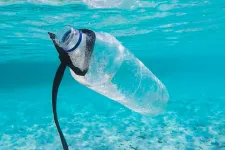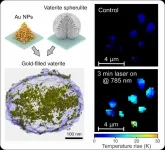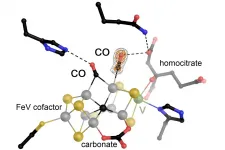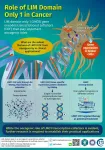Combating maritime litter
Helmholtz-Zentrum Hereon categorizes innovative solutions for fighting pollution in the oceans
2021-06-10
(Press-News.org) Plastic bottles drifting in the sea; bags in the stomachs of turtles; Covid-19 masks dancing in the surf: few images are as unpleasant to look at as those that show the contamination of our oceans. And few environmental issues are as urgent and as present in the public awareness. "Most people have an emotional connection to the sea. They think of ocean pollution as an attack on a place they long for," said Nikoleta Bellou, marine scientist at Hereon's Institute of Coastal System - Analysis and Modeling. Between 1990 and 2015 alone, an estimated 100 million metric tons of mostly plastic waste entered the oceans. For that instance the study fits to the UN Decade of Ocean Science for Sustainable Development, which started this year to emphasize a sustainable use of the seas.
The new overview study is the first to document the bulk of existing solutions--technologies as well as methods--regarding the prevention, monitoring, and cleanup with an innovative approach. With a view to the future, Nikoleta Bellou and together with an international team, namely Camilo A. Arrieta-Giron, João Canning-Clode, Chiara Gambardella, Konstantinos Karantzalos, Stephanie Kemna, Carsten Lemmen and João Monteiro, categorized and analyzed solutions from around the world. Led by Helmholtz-Zentrum Hereon, co-authors participants included the National Research Council of Italy, the Marine Environmental Sciences Centre, the National Technical University of Athens, the Smithsonian Institution, and Maritime Robotics.
Exploring all categories
The team looked at all categories and examined everything from crowdfunding projects to research databases. The scientists studied close to 200 solutions that plan to utilize drones, robots, conveyor belts, nets, pumps, or filters, depending on whether they will clean in coastal areas, at sea, or on the ocean floor.
To date, many developers have been using similar technological approaches, but there are indications that the next generation will increasingly rely on a wide variety of solutions. More and more, they will integrate machine learning, robotics, automation, big data analyses, and modeling. While the scientific community seems to focus mainly on monitoring and NGOs mostly emphasize prevention, most cleanup solutions result from the cooperation of different players, the study claims.
Rarely implemented
Still, most projects never move beyond the development stage. Very few solutions have become a technological reality or have been launched commercially. The study's authors point to the need to overcome the planning stage and think many issues through to the end. "The integration of solutions into policy guidelines should be pushed politically in order to establish a future industry," Bellou said. Based on research and data collection, the analysis reveals how thinly distributed and difficult to access such information can be. Most solutions--about 60 percent--were primarily geared toward monitoring and developed in the last three years.
Policy recommendations
The study addresses the limits of existing solutions as well as the challenges of developing new ones. It also makes political action recommendations. In addition to international cooperations between researchers and national environmental departments and agencies, the scientists recommend defining standards for each solution, such as assessments based on respective size, effectiveness, and an environmentally compatible footprint. This enables the creation of new funding programs that further develop both existing and new solutions, aided by a global database. "This is a way to encourage researchers as well as political decision makers to create a sustainable approach to bring maritime litter under control. We want to leave clean oceans to future generations," Nikoleta Bellou said.
INFORMATION:
[Attachments] See images for this press release:

ELSE PRESS RELEASES FROM THIS DATE:
2021-06-10
(Boston)--Medical education aspires to mitigate bias in future professionals by providing a robust curriculum that includes perspectives and practices for caring for sexual and gender minority (SGM) populations, including lesbian, gay, bisexual, transgender and intersex (LGBTQI) persons. To provide medical schools with a more systematic, uniform approach to teaching these topics in their curriculum, the Association of American Medical Colleges (AAMC) in 2014 published 30 SGM competencies and topics that curricula should address. However, implementation of these ideals remains challenging.
Building off the AAMC's comprehensive ...
2021-06-10
Breakthrough in metamaterials: for the first time in the world, researchers at Tel Aviv University developed an innovative nanotechnology that transforms a transparent calcite nanoparticle into a sparkling gold-like particle. In other words, they turned the transparent particle into a particle that is visible despite its very small dimensions. According to the researchers the new material can serve as a platform for innovative cancer treatments.
In a new paper published in Advanced Materials, an international team of scientists, coordinated by Dr. Roman Noskov and Dr. Pavel Ginzburg from the Iby and Aladar Fleischman Faculty of Engineering at Tel Aviv University, Prof. Dmitry Gorin from the Center ...
2021-06-10
Through the biological fixation of the element nitrogen by the enzyme nitrogenase, organisms gain access to molecular nitrogen (N2) in the Earth's atmosphere, which is essential for building cellular structures. In addition, a vanadium-dependent variant of nitrogenase can reduce the toxic gas carbon monoxide (CO) to hydrocarbons. These reductions of N2 and CO are among the most important processes in industrial chemistry, as they are used to produce both fertilizers and synthetic fuels. However, researchers have not yet been able to decipher the different pathways of the two reactions. Dr. Michael Rohde from Prof. Dr. Oliver Einsle's team at the Institute of Biochemistry at the ...
2021-06-10
The consumption of raw materials has increased notably in industry in general, and in the construction industry in particular, amidst growing concerns over sustainability issues. Concrete and mortar are the most commonly used materials in construction, and many studies are currently under way to try and reduce the harmful effects of their manufacture. Concrete and mortar are made by mixing water, sand, cement and aggregates.
"The main problem is the amount of cement used to produce this type of material; cement manufacturing uses a huge amount of energy and natural resources, which implies a high level of CO2 emissions. Diverse studies are under way aimed at reducing the quantity of cement required. We are working to replace cement and aggregates ...
2021-06-10
MINNEAPOLIS/ST.PAUL (06/10/2021) -- New findings from the University of Minnesota Medical School are helping uncover why some people are more likely to be overweight and develop Type 2 diabetes -- and it starts in the womb.
Previous association studies have shown that low birthweight among infants is a strong determinant for eventual obesity and Type 2 diabetes. The placenta of infants with a low birthweight have reduced levels of mTOR (mechanistic target of rapamycin), and the placenta of bigger infants have increased levels of mTOR. Building off of that research, a U of M Medical ...
2021-06-10
Genova (Italy) 10 June, 2021 - The U-Vip (Unit for Visually Impaired People) research team led by Monica Gori at the IIT- Istituto Italiano di Tecnologia (Italian Institute of Technology) has recently published a study which shows for the first time how children aged from 3 to 5 years old have problems in recognising the emotions of people wearing surgical masks. This collateral effect of the preventive measures linked to the Covid-19 health emergency could influence the correct development of children's capabilities of social interaction. The research paper has been published in Frontiers in Psychology.
The use of facemasks for children ...
2021-06-10
Actively restoring oyster reefs--beyond simply protecting them from harvest--can create big payoffs for habitat quality and the other species that flock to them. A new study from the Smithsonian Environmental Research Center (SERC), published June 3 in the journal Marine Ecology Progress Series, compared restored, protected and harvested areas using photos and video footage from roughly 200 sites.
Roughly a quarter of Maryland's oyster habitat lies protected in oyster sanctuaries. But only a small fraction of those sanctuaries have undergone full-scale restorations, with reconstructed reefs and new live oyster plantings. ...
2021-06-10
A new study reports that birds across the continental U.S. tend to avoid backyard feeders in louder areas. When light and noise pollution were both present, even more species stayed away.
The study, published in Global Change Biology, used data from the community science program Program FeederWatch. The research team analyzed more than 3.4 million observations of 140 different bird species across the continental U.S.
"Broadly speaking, we are just starting to dive into the consequences of light and noise for animals," said Ashley Wilson, a graduate student at California Polytechnic State University who led the study. "Most studies focus on a single species' responses to noise or light pollution. As such, our study involving 140 species provides the most comprehensive assessment ...
2021-06-10
Humans have been plagued by a myriad of deadly cancers since ages. Parallelly, they have also been attempting different permutations and combinations of treatments to cure the disease. Part of these attempts involving biomolecular targets have come to the fore in recent years. Like a broad-spectrum antibiotic that can attack and eliminate several microbes at a time, some of these biomolecular targets, when manipulated appropriately, can alleviate different cancers. One such biomolecular target of interest is LIM domain only 1 gene (LMO1).
LMO1 codes for a protein 'connector' that helps in the assembly ...
2021-06-10
Increasing evidence shows that physical activity and exercise training may delay or prevent the onset of Alzheimer's disease (AD). In aging humans, aerobic exercise training increases gray and white matter volume, enhances blood flow, and improves memory function. The ability to measure the effects of exercise on systemic biomarkers associated with risk for AD and relating them to key metabolomic alterations may further prevention, monitoring, and treatment efforts. However, systemic biomarkers that can measure exercise effects on brain function and that link to relevant metabolic responses are lacking.
To address this issue, Henriette van Praag, Ph.D., from Florida Atlantic University's ...
LAST 30 PRESS RELEASES:
[Press-News.org] Combating maritime litter
Helmholtz-Zentrum Hereon categorizes innovative solutions for fighting pollution in the oceans







